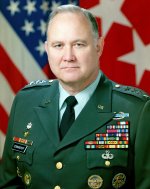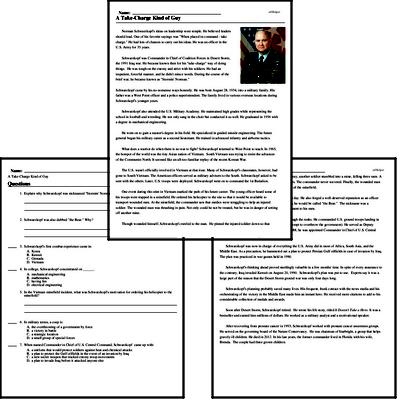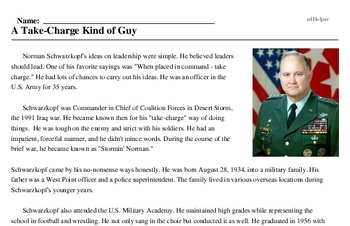A Take-Charge Kind of Guy
Norman Schwarzkopf
Reading Comprehension for August 22
Norman Schwarzkopf's ideas on leadership were simple. He believed leaders should lead. One of his favorite sayings was "When placed in command - take charge." He had lots of chances to carry out his ideas. He was an officer in the U.S. Army for 35 years.
Schwarzkopf was Commander in Chief of Coalition Forces in Desert Storm, the 1991 Iraq war. He became known then for his "take-charge" way of doing things. He was tough on the enemy and strict with his soldiers. He had an impatient, forceful manner, and he didn't mince words. During the course of the brief war, he became known as "Stormin' Norman."
Schwarzkopf came by his no-nonsense ways honestly. He was born August 28, 1934, into a military family. His father was a West Point officer and a police superintendent. The family lived in various overseas locations during Schwarzkopf's younger years.
Schwarzkopf also attended the U.S. Military Academy. He maintained high grades while representing the school in football and wrestling. He not only sang in the choir but conducted it as well. He graduated in 1956 with a degree in mechanical engineering.
He went on to gain a master's degree in his field. He specialized in guided missile engineering. The future general began his military career as a second lieutenant. He trained in advanced infantry and airborne tactics.
What does a warrior do when there is no war to fight? Schwarzkopf returned to West Point to teach. In 1965, the hotspot of the world was the tiny Asian nation of Vietnam. South Vietnam was trying to resist the advances of the Communist North. It seemed like an all-too-familiar replay of the recent Korean War.
The U.S. wasn't officially involved in Vietnam at that time. Many of Schwarzkopf's classmates, however, had gone to South Vietnam. The American officers served as military advisers to the South. Schwarzkopf asked to be sent with the others. Later, U.S. troops were deployed. Schwarzkopf went on to command the 1st Battalion.
One event during this stint in Vietnam marked the path of his future career. The young officer heard some of his troops were trapped in a minefield. He ordered his helicopter to the site so that it would be available to transport wounded men. At the minefield, the commander saw that medics were struggling to help an injured soldier. The wounded man was thrashing in pain. Not only could he not be treated, but he was in danger of setting off another mine.
Though wounded himself, Schwarzkopf crawled to the man. He pinned the injured soldier down so that medics could set a shattered leg. A few footsteps away, another soldier stumbled into a mine, killing three men. A liaison officer lost his leg before Schwarzkopf's eyes. The commander never wavered. Finally, the wounded man was stabilized. Schwarzkopf led his men safely out of the minefield.




